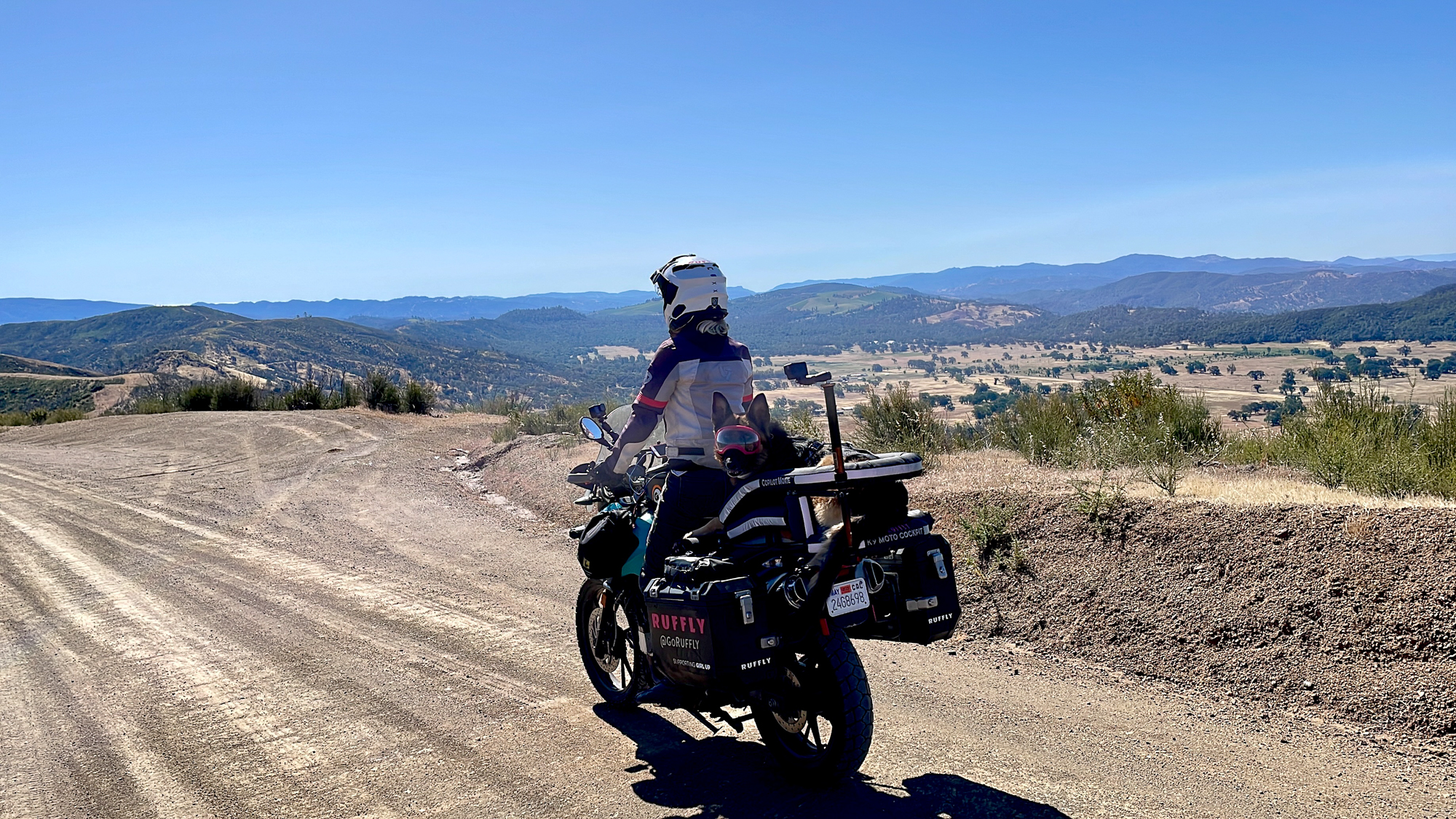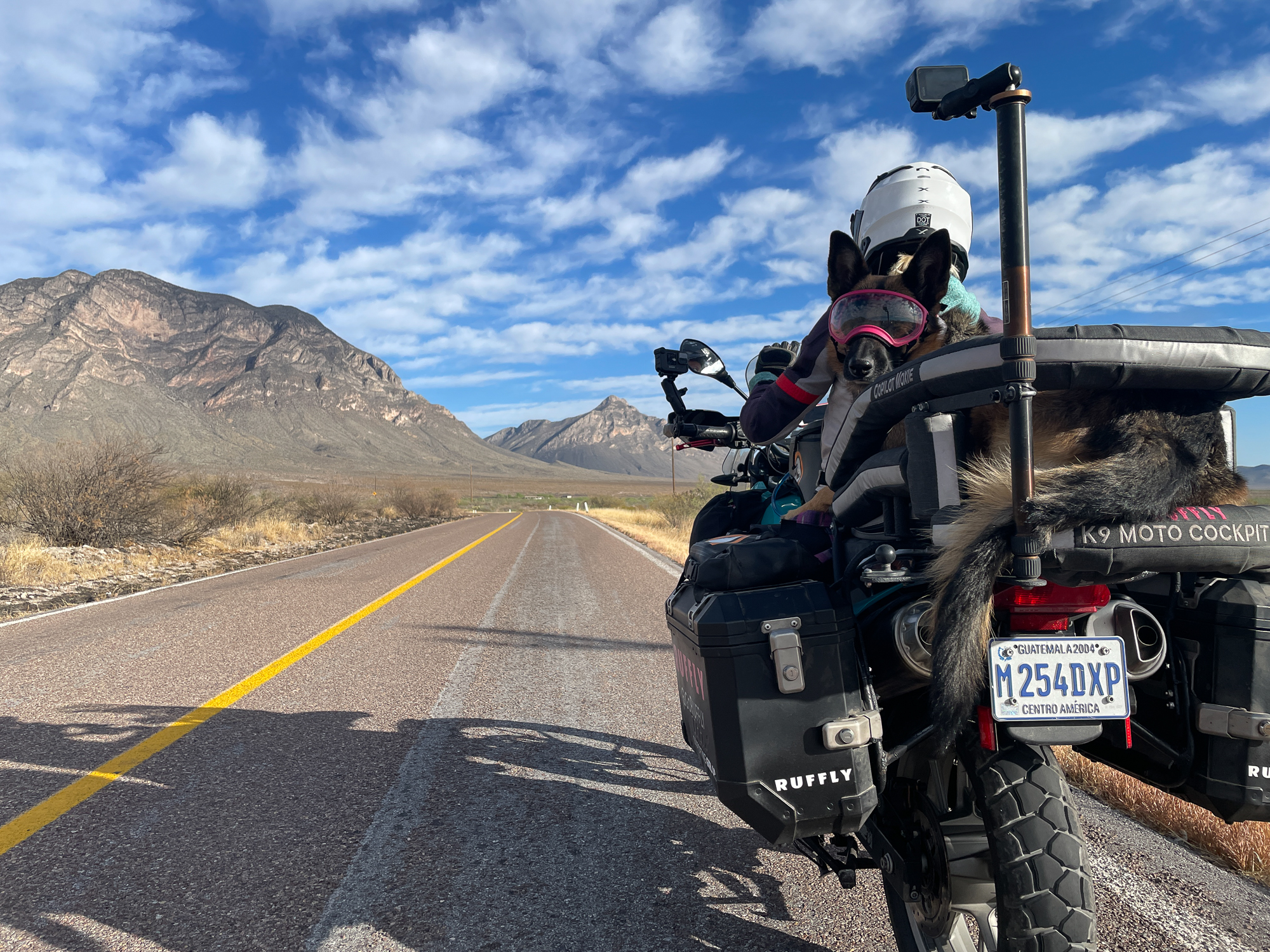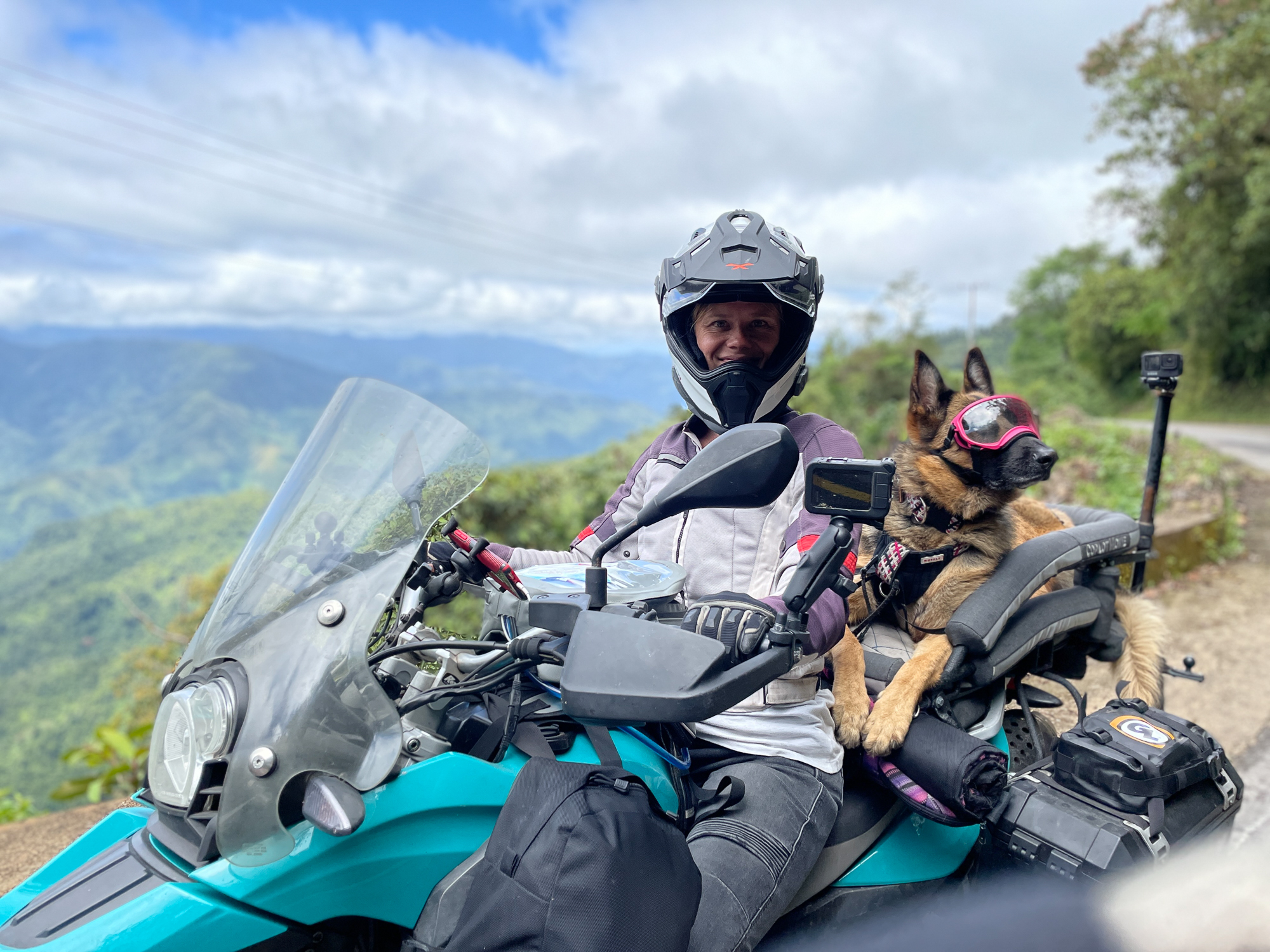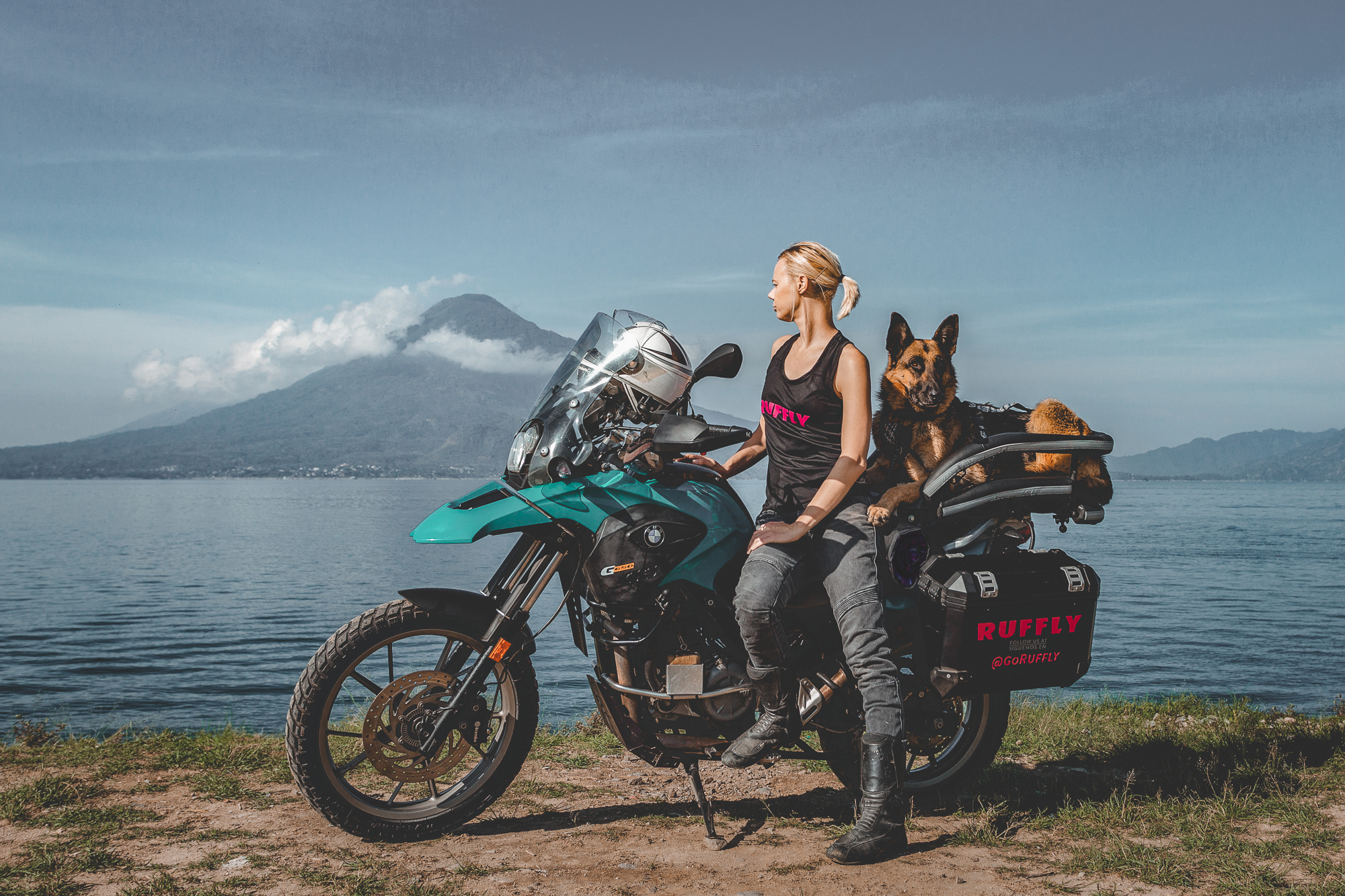Jess Stone admits that while riding the length of the Pan-American Highway from Los Angeles to Ushuaia, Argentina, she struggled. Imposter syndrome loomed. Doubts filled her mind. Did she belong on a bike? But sometimes, confidence builds gradually and morphs into something bigger. The Dalai Lama must have known this well: “With realization of one’s own potential and self-confidence in one’s ability, one can build a better world.” This is exactly what Jess is all about.
Currently, amid a round-the-world trip with her husband, Greg, and their German shepherd, Moxie, Stone is using her newfound confidence as an entrepreneur to help instill a sense of self-worth in others. Partnering with Girl Up, a non-profit focusing on building girls’ “skills, rights, and opportunities to be leaders,” Stone’s goal is to raise $100,000 over the next two years.
In this interview, Jess shares her experiences learning to ride a motorcycle in Liberia, West Africa, what it was like living in Guatemala, and what inspired her to create a canine moto cockpit fit for a 90-pound dog.
Why did you start riding adventure motorcycles?
I learned to ride about nine years ago in Liberia, West Africa, where my husband and I were international aid workers. We met in South Sudan. He had a dream to do a North to South America trip, and his idea was that in a year, he was going to quit his job and do it. We had just gotten together and were in a new relationship. He said I could come along, but I had to learn how to ride my own bike.
How long did you spend training in Liberia? What kind of terrain did you encounter?
We probably spent about six months practicing while I was learning to ride, mostly on bombed-out side streets. We were in Monrovia, which is the capital. The main roads were fine (they were paved), but we practiced on little side residential roads which often turned into dirt or sand because we were right at the beach. It wasn’t an easy place to learn. It’s not like I had a wide-open parking lot and cones like in the States.
Your training in Liberia tended to gather an audience.
I was anxious about it because I was always surrounded by men who were watching. It was such a unique thing to see a woman ride, so that caused me even more anxiety. But the funny thing is, I guess those guys got the idea to teach their wives or girlfriends to ride because soon after, around the time we were leaving, I saw two other guys teaching girls how to ride right in our neighborhood. They were on the same type of bike, too. I think they must have gotten some inspiration from watching Greg teach me. It was interesting to see because a lot of people have those small bikes in Liberia. Cars are so expensive, right? And we were in a place that was post-conflict. The towns are far from each other, and public transit isn’t used as widely there, so having a bike really makes a difference. It was great to see those women learning to ride.

What was the overall learning experience like for you?
I had never driven a standard car, and I’d only really been on the back of bikes, nothing major. This is going to be easy-peasy, I thought. Not a problem! [But] it didn’t happen like that. We bought a 160cc bike, a little street bike in Liberia, and Greg taught me how to ride. I was not a very good student. I guess having your significant other teach you is never the best thing, but he did a great job. He was really patient. I was digging my heels the whole time, putting all this pressure on myself. I knew we were going to do this trip and didn’t want to give up.
I only had about 1,000 kilometers of experience on that bike before we went to Los Angeles, where Greg is from, and bought our BMW motorcycles. I went from my 160cc to a 650cc. It was a big jump. We spent the first two months doing some practice trips around LA, and I was just so worked up about the whole thing. I would spend days [thinking], I just want to stay in bed today. Greg couldn’t understand because he was so excited about it. His girlfriend was coming on this trip with him. He was doing the thing—a dream of a lifetime.
Were you afraid of an accident or injury, or was it a lack of confidence?
I wasn’t worried about hurting myself but was more concerned about damaging this new bike that I just bought—so much so that I didn’t ride it back from the dealer. I had this anxiety about riding in general, not feeling confident in my skills and feeling like everyone was watching and judging me. It was like, “What right does she have to be riding? She doesn’t know what she’s doing on a big bike.” All of those things go through your head. I think other women have had similar experiences. Not necessarily in motorcycling, but in different things they try, especially in a male-dominated sport. It’s hard to feel comfortable when you have those ideas going on in your mind. Because we were in LA, there were a lot of other riders around, and everybody was really positive. But it was [up to] me to get through my own stuff to become a better rider.
You and Greg started riding south through Mexico and Central and South America in 2013. Did you gain confidence as you continued, or did you feel like you struggled along the way?
I struggled the whole way. I was always concerned about what was coming next on the road because there were a lot of detours. Dirt sections caused me anxiety because it wasn’t like I could end the day and feel like tomorrow would be better. Tomorrow could be worse. That just kept building and building, and by the end, I was doing a lot of dirt but sitting down. I wasn’t standing the way that you should. I didn’t have the skills I should have had, mainly because I wasn’t ready to learn them when we started. I adapted to get through it. That was my coping mechanism.
By the end [of the trip], I had imposter syndrome. You know, that feeling that you’re not as good, and you’re going to be found out. I still had that feeling like I’m not really a rider. Yeah, I did this thing, but other people have done so much more. It was an 8-month trip, and I was like, okay, let’s move on to the next thing.

What was the next move for you?
After the trip, we moved to New Orleans and lived there for two years. It was a complete change from being on the road. It was normal and easy and gave me time to think through everything. But after those two years, I was like, we need to travel again. That was the longest we had stayed in a place at one time. That’s where Guatemala came in. Greg got a job working for a women’s microfinance non-profit running their health program. It happened to be in a place we really liked in Lake Atitlan. It’s a beautiful area. We put our stuff in storage and rode down to Guatemala.
This is where you found your German Shepherd, Moxie.
It was always my dream to have a dog, but I never got one because we had been living overseas, and then we were moving from New Orleans. When we got to Guatemala, we knew we would be there for at least two years. A breeder on the other side of the lake brought his two shepherds from the States. I went over and saw the puppies and fell in love with them. The one I wanted was called White Paw. I loved that dog so much, but that dog couldn’t have given a crap about me and was running the other way when I was sitting there.
Meanwhile, Moxie was trying to jump on my lap and be loved. We adopted her when she was about eight weeks old. Her father was 120 pounds, and her mom was 90 pounds, so I knew this was going to be a big shepherd.
You were keen to bring Moxie along on your adventures. How did you fit her on the back of your motorcycle?
We looked online to see what options there were for a dog that was going to be between 70 and 90 pounds. There are sidecars and trailers out there. I know many people take their dogs on those, especially big dogs. You can tell from my story that I’m a bit anxious, and I finally felt comfortable on my bike the way it was. I didn’t want to add another complication to it. Plus, those things are hard to find overseas and are expensive. I thought, there’s got to be a way that she could be on the back as if she were a passenger.
We saw those pizza delivery motorbikes with the big shell on the back. Maybe we could convert something like that so she could be in there? We had a connection with a local metal shop just down the street, so we designed what is now the frame of her canine moto cockpit, where she would be lying down right behind me.

This was something for your bike specifically, right? It didn’t morph into a business until later.
I didn’t think anything more would come of it; we just wanted a way to take Moxie along. But while that was happening, we had another [project] that was sort of connected to Greg’s job. The non-profit also included a group of women artisans—indigenous Guatemalan women who used traditional weaving techniques and created things like scarves, clothing, or jewelry. When I had Moxie, one of the missing things was that I wanted dog gear that looked as beautiful as those vibrant colors in Guatemala but was still durable enough for my big shepherd. The local stuff on the market was made of leather and wasn’t as bright and beautiful as I expected. I thought there had to be a way to pair more durable materials with these textiles. We connected with some artisans and started making prototypes of collars for Moxie. While we were figuring out a way to carry her along, I was also figuring out a way to outfit her in stuff that I liked and that was doing good for the people helping us. That’s how Ruffly was born, which is our ethical outdoor dog gear brand. We grew from collars to leashes, bandanas, beds, and a range of gear meant for adventurous dogs like Moxie.
The moto cockpit initially took off because of social media. How did people react?
I was still working remotely for my marketing job at that time, and we were slowly getting going with the dog products. The cockpit came into play because people saw on social media that I was riding with Moxie and then asked, “Where did you get that carrier? How can I do that?” We didn’t want to get into a whole manufacturing business then, so we put out a 35-page guide about how to create something similar. But then people came back and said, “Well, I’m getting quoted high prices from these custom shops because it’s a one-off build, and it’s going to take months until they can get it to me. Is there any way you can make it for me and send it out?” That’s how the cockpit business started. Two years later, we have a couple of hundred riders around the world riding with their big dogs.

At some point, you wanted to continue traveling. Had you been thinking about another long-term trip for some time?
We were receiving a lot of requests from people to be brand ambassadors for Ruffly, and we thought that was cool. But we also thought, who would be a better brand ambassador than the owners? And what adventure rider doesn’t want to do a round-the-world trip? That was always on the spectrum for us, more so for Greg than me. We got to a point where I started thinking, We need to go and do something. We need to show this product to the world and see how other people can do it too. But I didn’t want to do it solely as a brand ambassador. There had to be some meaning behind it.
We were aid workers and had connections with non-profits, but there was one I was excited about. The organization is called Girl Up. They were founded by the United Nations Foundation and provide leadership and development training to girls worldwide. They work in 120 countries and provide [girls] with the tools to build their confidence to [develop] the skills they need to advocate for issues that matter most to them.
I always thought if I had something like that when I was younger, I could imagine how much further I would be in my life right now or how different I would be having that confidence. I thought, why don’t I partner this dream of doing an around the world [trip] with an organization we can support? We decided to partner and are going to raise $100,000 for Girl Up over two years.

If you want to work with a non-profit, how do you decide how much money to raise?
It depends. I asked that question at the beginning as well. When we were in Guatemala in 2016, British writer Henry Crew wanted to be the youngest male to ride around the world. He was doing it for the Guinness Book of World Records and partnered with Movember [to raise awareness] about men’s health issues. I asked him those same questions. Henry considered how much he thought he could gather during his trip based on the time on the road and the types of events he would (or wouldn’t) do. That gave us a good idea in terms of our goal, but the other aspect is that 10 percent of all our gear sales go towards the fundraiser, so Ruffly as a business is also going to help us reach that goal. We also outlined what we plan to do, including the number of events and corporate sponsors, then Girl Up laid out what they would do in terms of marketing visibility. It was give and take.
What does your round-the-world itinerary currently look like?
We started the trip on March 5 from Guatemala. We went up through Guatemala and Mexico, crossed into the States, and now we are on our way up north. Initially, we were going to go to Prudhoe Bay in Alaska, but just recently decided to make our way up to Fairbanks and then cross back into Northwest Territories to the Arctic Ocean, where the road ends. Then we’ll go across Canada to Toronto, where I’m from. From Toronto, we’re going to fly the bikes, Moxie, and ourselves to Barcelona and go south to Morocco so we can start West Africa down to South Africa and back up the eastern side. We’ll enter Europe in summer 2023 and go east through the Stans, India, Pakistan, and hopefully China and Malaysia. That’s where we’ll ship the bikes to Buenos Aires in Argentina and end in Guatemala.

You’re feeling much more confident on the bike these days. What do you think was the most impactful step to getting there? Was there a point where it shifted for you, or do you still struggle with it?
Yes, I still have nerves, but I’ve gotten a lot better. I’ve taken several off-road courses now, but it really switched for me when we were in Guatemala. I started thinking about the last trip and how that all worked out. I realized that I accepted that challenge when I said let’s do this around-the-world trip. I’m going to do it, and I can ride. I’m a rider and will show everybody I’m a rider. It’s not beyond me. Having that mindset made the difference for me. I didn’t feel anxious about it anymore.
Do you have any advice for someone who wants to learn to ride a motorcycle or gain confidence on the bike?
Two key things. One, get a bike that that that you feel comfortable on, even if that means getting a used bike that’s smaller and you know that you’re going to outgrow. It’s about gaining confidence on something smaller rather than starting with something big and getting over that hurdle. The other thing is to take the courses. Take the weekend class where they teach you the skills, then practice. That’s also key. I’m also one of those who continue to go back to level one, and the main reason is that after I do the course, I feel confident. But you have to practice.
To learn more about Jess, Moxie, and Greg’s trip, visit the GoRuffly website, YouTube channel, Facebook page, and Instagram account.
Our No Compromise Clause: We carefully screen all contributors to ensure they are independent and impartial. We never have and never will accept advertorial, and we do not allow advertising to influence our product or destination reviews.


